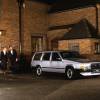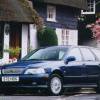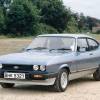
RAC sale – up to 33% off*
• Roadside cover from £5.29 a month†
• We get to most breakdowns in 60 mins or less
• Our patrols fix 4/5 breakdowns on the spot

BY ANDY ENRIGHT
Introduction
If you subscribe to the view that Volvos should look as if they were designed with a setsquare and a ruler, then the 480 series, launched in 1986, must have come as a huge shock. This coupe-cum-estate harked back to the P1800, last seen in 1973, and offered a viable alternative to the GTi hatches that were in vogue in the mid Eighties. Although never highly renowned as a driver's car, the 480 developed into a durable, well equipped and stylish car that offered the usual Volvo attributes of no-nonsense interior design and unimpeachable safety in a package that was a little sassier than the norm. The 480 series may have represented quite a mental hurdle for many to overcome, but clear it they did, the model selling in respectable numbers. Finding a decent used example shouldn't be difficult as long as you're not buying at the bottom of the market.
Models
Models Covered:
480 three-door hatchback, 1.7, 1.7 turbo, 2.0, [S, ES. SE, Turbo, GT, Celebration]
History
The Volvo 480 didn't have the easiest start to life, being originally designed way back in 1978 to replace the P1800. 'Project E12' was beset by difficulties and it wasn't until 1985 that magazines started scooping what was to become the 480ES. The car made its official debut at the 1986 Geneva Motor Show, the project originally commencing in Gothenburg but then being unceremoniously shipped out to the Netherlands. Rapidly facilitating the demise of Volvo's erstwhile 'sporty' hatch, the 360GLT, the 480ES sold in respectable numbers in the UK, despite the fact that its Renault derived 102bhp 1.7-litre engine wasn't from the top drawer. A swifter 120bhp turbocharged version was introduced in December 1988 and a budget S version of the normally aspirated car followed in October 1991.
The biggest improvement in the car's lifetime arrived in September 1992 with the fitment of a 2.0-litre 110bhp engine. A number of detail improvements were visited upon the car in September 1993, including the fitment of a driver's airbag, seatbelt tensioners and side impact protection. A 2.0-litre GT limited edition version was introduced in June 1994 which enjoyed a three month production run, then being redesignated the SE. A final 2.0-litre Celebration version was unveiled in May 1995. With a final production run of 480 cars, this model, with two-tone leather upholstery, a CD stereo, alloy wheels, air conditioning and a commemorative plaque is the car 480 collectors - and yes, they do exist - value above all others. The cabriolet car shown at the 1990 Geneva Motor Show could well be the exception to that rule. Based on a 1986 design by Steenstra, this car sadly never made series production due to the bankruptcy of one of the tooling suppliers.
What You Get
The Volvo 480ES was, despite its troubled genesis, a fairly advanced car for its time. Even the earliest cars utilised modern composite materials for the front end, with side intrusion bars being fitted before many rivals. In fact the car exceeded crashworthiness test requirements by quite some margin. A bonded windscreen, recessed windscreen wipers, illuminated door locks and follow-me home headlamps were also ideas some way ahead of their time.
The interior is a good deal more spacious than the three-door layout suggests, with a folding 50/50 rear bench and enough room for four adults. A height adjustable steering column and multi-adjustable driver's seat allowed for a comfortable driving position. A side effect of the front-wheel drive layout was excellent space in the boot. This featured stowage bins in the side trim panels and a lockable central box between the rear seats. A well in the boot floor could be used to keep valuables out of sight as could a retractable cover for the load bay.
What You Pay
Please fill in the form here for an exact up-to-date information.
What to Look For
The 1.7-litre engines are notoriously rattly, especially at idle and most buyers will prefer the smoother 2.0-litre unit. Early cars also had a system that linked the speed of the windscreen wipers to the car's forward velocity but this often went haywire along with the electronic information centre. The pop up headlamps are also very prone to failure and those that do still work often squeal like a stuck pig upon operation. Look for rust problems around the car's sills and tailgate openings. The seats are also not made from the most hardwearing materials.
Replacement Parts
(based on a 1994 1.7 480 ex Vat) A clutch assembly will be around £140 and a new catalyst around £400. An alternator should be close to £190 and a radiator around £175. A new tail lamp is around £65. A windscreen should be in the region of £115.
Servicing costs may well surprise you on later models, particularly if you still hold to the view that Volvos are expensive to maintain. Where workshop visits once were required every six months, these need attention only once a year or every 10,000 miles, whichever comes sooner.
On the Road
Although none of the engines really had as much power as the sleek styling suggests, the 480 wasn't a bad car to drive. The standard 1.7-litre car would top out at 110mph and get to 60mph in 9.3 seconds, which is by no means sluggish and the turbocharged model could knock another second off this figure. The rear suspension was a somewhat primitive track beam axle on coil springs, so handling wasn't particularly exciting, but roadholding limits were quite high.
Overall
Not outstanding in any key respect, the Volvo 480 series is nevertheless an interesting car and represents a period in the Swedish company's history when it was in a period of rapid change. The later 2.0-litre engined cars are the ones to look for but if you just want a cheap car that stands out from the crowd without being too much of a liability, the 480 is tough to beat.







